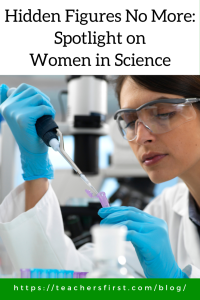April 25 is National DNA Day, commemorating the 1953 double helix discovery and the subsequent completion of The Human Genome Project in 2003. James Watson and Francis Crick discovered the double helix; however, several women, including Rosalind Franklin, Martha Chase, and Barbara McClintock, made notable contributions yet aren’t as well-known in the scientific community.
Despite widespread recognition of women’s underrepresentation in STEM careers, the proportion of women pursuing STEM fields has remained relatively stagnant. The chart on this page shows that the number of women graduating in STEM fields only increased by two percent between 2015 and 2022.
Sharing authentic and genuine accomplishments of women in STEM careers allows girls to see STEM as exciting and relatable when considering their educational goals and future careers. TeachersFirst’s new Special Topics page, Changemakers: Women in STEM, features over twenty resources dedicated to featuring the breakthroughs and accomplishments of women in STEM fields.
One excellent resource included in the Changemakers: Women in STEM Special Topics collection is the If/Then Collection (reviewed here). It provides access to authentic and relatable images of real women in STEM, including videos, photos, educational activities, and partner collections. Diverse careers in STEM featured on the site include explorers, sports, health fields, conservation, and more.
Keeping National DNA Day in mind, let’s look at the information about women in genetics shared by If/Then.
- Printable Posters – This free, downloadable poster series, “This is What a Scientist Looks Like,” features three women scientists. Click on the share link of the thumbnail image and accept the user agreement to access the document in several different formats, including a code with a direct link, embed code, or a shareable link, such as this poster featuring Dr. Ahna Skop.
- Videos – Check out these profiles of women in genetics and discussions of how they use STEM in their jobs. In this video, Lauren Esposito discusses her work in the lab and out in the field, along with her collection of North American scorpions, the largest in the world.
- Activity Sheets – This searchable collection offers several options for hands-on experiments and activities, such as this one provided by GoldieBlox, a partner of If/Then, which demonstrates how to use Microscopic Marbling to recreate how cells look under a microscope.
Dig deeper into the resources provided by If/Then by visiting the Educator Hub. This hub includes no-cost, standards-aligned classroom activities, lessons, virtual camps, and free science-of-the-month toolkits.
- Get in the Game – This resource shares educator and student guides with instructions on building a board game to practice computational thinking skills of abstraction, decomposition, pattern recognition, and algorithms. The student handouts include links to videos that teach each skill, and the educator guide provides detailed instructions for the activity.
- Printable Workbooks – Explore five STEM careers, from soil science to coding for wildlife. Each workbook features a biography of a woman scientist and several pages of student activities.
- DonorsChoose If/Then Collection Innovation Challenge Projects – Check out and get inspired by these ten innovative and winning classroom STEM projects. Create a project on DonorsChoose using the examples and receive 3x donations, so every $10 donation to your project becomes $30!
Sharing the accomplishments of women in STEM fields encourages girls to consider careers in science, technology, engineering, and math. By highlighting the breakthroughs of female changemakers in genetics, physics, engineering, and more, we encourage the next generation of girls to envision themselves as future scientists, engineers, and mathematicians. While achieving gender equity in STEM will take continued effort, honoring the accomplishments of women in STEM today inspires the next generation of leaders in these fields.
What resources do you use to feature women in STEM careers? Please share your ideas in the comments below as we learn together.



This blog does a commendable job of highlighting the significant yet often overlooked contributions of women in science, particularly in relation to the discovery of the DNA double helix. It’s essential to acknowledge these hidden figures and continue addressing the gender disparities in STEM fields. The stagnation in the growth of women pursuing STEM careers, as shown in your chart, underscores the need for ongoing efforts to encourage and support more women in these areas. Celebrating National DNA Day by recognizing all contributors, regardless of gender, can inspire a more inclusive and diverse scientific community. Great piece, Sharon!